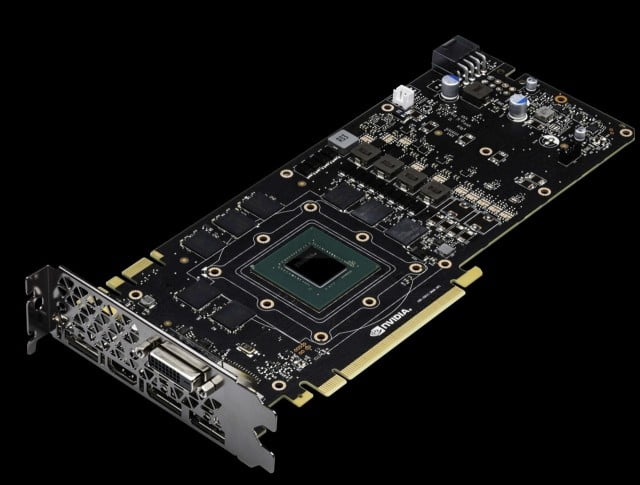
When Nvidia launched the GTX 1080 earlier this month, it established its new Pascal-derived GPUs as leaders in the top of the market. Now, as expected, the GTX 1070 has dropped, piledriving both Nvidia’s previous cards and every top-end GPU AMD has to offer.
First, let’s hit the technical specifications. The GTX 1070 packs 1,920 CUDA cores, 120 texture units, and 64 ROPS. That works out to 75% the cores and texture units of the larger GTX 1080, but the pixel fill rate is theoretically the same between the two cards, since they have the same number of ROPS. Base clock is 1.5GHz with boost clocks up to 1.68GHz and 8GB of 8Gbps GDDR5 memory (the GeForce GTX 1080 uses 8GB of 10Gbps GDDR5X memory). Memory bandwidth is 256GB/s, which puts the new GTX 1070 in between the older GTX 980 (224GB/s) and the 980 Ti (336GB/s).
As expected, this positions the GTX 1070 as a cut-down version of the GTX 1080, though hopefully without any of the issues that dogged the GTX 970’s memory configuration. The GTX 1070 has a few changes compared with the 1080 as a result — it uses an aluminum finned heatsink rather than the vapor-chamber cooler that the GTX 1080 fielded, and it has a four-phase power supply rather than the GTX 1080’s five phases.
Overall performance, meanwhile, is simply excellent. Over at Tom’s, Chris Angelini shows the GTX 1070 taking second only to the 1080 in Battlefield 4, Project Cars, Rise of the Tomb Raider, the Division, Witcher 3, and Grand Theft Auto V. AMD fights back in games like Ashes of the Singularity and Hitman, but the GTX 1070’s base price is $379 while the Founder’s Edition is $449. The Fury X, Fury, and Radeon Nano are all substantially above this, at $500+.
Hot Hardware presents similar results in somewhat different titles. The GTX 1070 is faster than the Fury X in Shadows of Mordor and Thief. HH also posted some power consumption data on these cards, which is where the 1070 really shines:
The 1070 draws over 100W less power than the Titan X while outperforming it in the majority of titles. That’s a stellar achievement for Nvidia and a huge win for gamers.
The 1070 is the new card to beat
This is the part of the review where we normally cover what’s likely coming from AMD to counter the new 1070/1080 challengers. In this case, however, I don’t expect AMD to launch a card that goes head-to-head with Nvidia because the firm has made it clear that Polaris 10 and 11, which launch in the not-so-distant future, are targeting different price points. With that said, however, these new GPUs are a line in the sand that AMD will have to contend with — and it better have brought its A game when Vega launches at the end of 2016. AMD can stake out a profitable position in the midrange and budget spaces with a new Polaris and probably win some market share in mobile, but the halo effect from the 1070 and 1080 could be significant.
The uglier and inconvenient truth for AMD, however, is that until it launches Vega, it’s going to be stuck with the Fury X, Fury, and Fury Nano to anchor its high end — and the GTX 1070 has just blown those cards out of the water. With the GTX 1070 Founder’s Edition coming in at $449 and the base card at $379, AMD needs to slash the price on Fury X to between $350 and $400 in order to compete. That would make the Fury a $300 – $350 card, and likely push the Nano into similar territory.
Now, a Fury X at $350 would still be an extremely potent graphics card, but it’s not clear if that kind of pricing is feasible given the difficulty of building HBM cards and the overall interposer price. While AMD has argued that HBM is more cost-effective than GDDR5 at the highest performance levels, there’s a reason why the company is using GDDR5 for its Polaris hardware — there’s a point at which HBM simply doesn’t make financial sense. Given Fiji’s large die size, there’s also a minimum point at which AMD can sell the card and still break even. This could limit how much AMD cuts prices, but price cuts for the Fury family are almost certainly inbound. One way or the other, this is going to put deep pressure on AMD’s entire GPU product line — if the Fury X is slashed to $350-$400 to hold its value against the 1070, that means the R9 390X needs its own price cut as well. Presumably AMD will cut cost on the Fury family, launch Polaris, and then retire all the GPU models obviated by this two-tier approach.
Final note: When the Oculus Rift and Vive launched, we recommended taking a wait-and-see approach before investing in current hardware for the purposes of gaming in VR. That approach has been thoroughly vindicated by the performance of both the GTX 1080 and 1070. The 1070 in particular beats the Titan X, can leverage the same VR-improving technologies as the 1080, and yet costs less than half as much as Titan X (and significantly less than the GTX 980 Ti). In games that support Nvidia’s GameWorks VR, the gap between Titan X and 1080/1070 should be even larger, and anyone who bought a VR-ready system with a GTX 970 or 980 class card in it is likely kicking themselves now. Yes, faster GPU tech is always under development, but sometimes the leaps between product generations are larger than others. The 1080 / 1070 improvements are quite significant — now is a much better time to buy into VR than just a few months ago.




